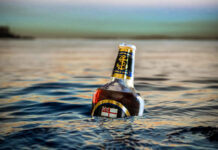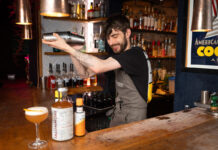WITH a range of around 250 whiskies to choose from, it can sometimes be difficult for customers at Glenesk Country House Hotel to decide what they want.

The whisky bar is one of the unique selling points of the 36-bedroom premises and is said to be hugely popular with guests, who often plan return visits.
Managing director Dylan Wren, who is originally from Yorkshire, bought the premises in Edzell, Angus, three years ago and has upped the focus on whisky.
There are currently more than five hundred whiskies on the back-bar, with 250 for sale and the rest “for display purposes”.
“We’ve got 546 whiskies just now, but we are going to go to 1000,” Dylan told SLTN.
“It’s something completely different for the area which people like and we get a lot of repeat business because of it.”
The hotel attracts a broad clientele, including golfers, hunters and fishermen; and their level of knowledge on whisky varies greatly, according to Dylan.
“There’s no pattern to our customers whatsoever,” he said.
“A lot of people have a wealth of knowledge and with others, it’s very basic.
“I first try and find out if they want a peaty or smoky whisky, or if they want something smoother like a Speyside.
“There are also some customers who want a local malt like a Fettercairn or a Glencadam. I think we’ve got a bigger collection than Glencadam themselves; it’s popular because it’s local.”
Dylan said the Glenesk has a good relationship with the nearby Glencadam Distillery in Brechin, which arranges free tours for the hotel’s guests, and a Glencadam malt is the most expensive whisky in the bar, coming in at £49 a nip.
Historically, the area was home to the Glenesk Distillery; it was mothballed in 1985 but its whisky is still available at the hotel bar.
Not everyone will be in search of a rare 30 year old single malt, of course, and Dylan said he’s careful not to alienate new whisky drinkers – steering novices in the direction of a gentler tipple that will not put them off.
It’s only if they have a fair amount of knowledge and expertise that he will suggest a more complex dram.
“If people are real beginners, there’s no way I would recommend a peaty whisky or a cask strength,” he said.
“You just have to break them in softly and gently.”
Most novices, he claims, tend to order internationally well-known brands such as a Glenfiddich, Glenlivet or Glenmorangie.
But once they are a little bit more versed in the spirit they get more confident and he will recommend something different, such as a dram from Speyside distillery Tomintoul.
Among the more knowledgeable customers, Dylan said, there has been increased demand for whiskies with different cask finishes.
“We get a lot of requests for different finishes and people seem to especially like the sherry finishes.”
That’s not the only subject that’s proved popular with whisky fans at the bar.
One of the hottest topics includes the best way to drink whisky.
Dylan said he doesn’t tell customers what to have with their whisky because he says it’s up to the individual drinker and varies from one person to the next.
“It’s everybody’s own personal choice what they put in their whisky,” said Dylan.
“It’s written that you should put a little drop of water in it because it opens up the palate.
“I’ve seen people that will happily order a really nice 21 year old whisky and then flood it with water.
“But a lot of people don’t like that and personally, I just like it as it comes.”
Another popular topic is the best age for a whisky.
This, said Dylan, always provokes a bit of debate among aficionados of the drink.
But from his own perspective, he believes a whisky has peaked when it reaches four decades.
“A 40 year old whisky, I think, is tops and as old as you should go with a whisky,” said Dylan.
“And personally speaking a 30 year old Fettercairn malt is the absolute pinnacle for me.”



















